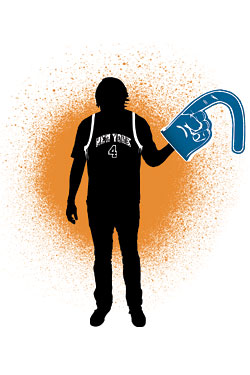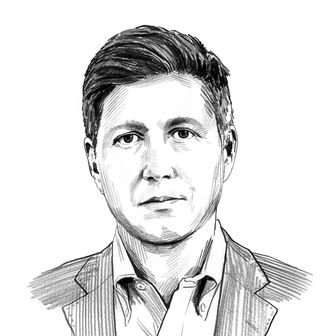
A s President Obama could tell you, there comes a certain point in your administration when the predecessor’s mess becomes your mess.
When Donnie Walsh took over as the Knicks’ president eighteen months ago, his mission was clear: Clean up Isiah Thomas’s carnage. Thomas’s ineptitude as an executive has been exhaustively documented—my personal favorite is still the $30 million over five years he gave to Jerome James, or $134,529 for every point James scored in his career as a Knick—and few thought Walsh could possibly succeed in crawling out of the salary-cap grave in which Thomas had buried the team. But he did, trading away or waiving seven of the twelve players Isiah left him within his first eleven months on the job, giving the team a puncher’s chance at the vaunted free-agent class of LeBron James, Dwyane Wade, and Chris Bosh come summer 2010. It was a monumental achievement.
What was most noteworthy about the moves was their acceptance by the fan base. No one minded that by gutting the team, Walsh was ceding two seasons (at least) for long-term viability. The old adage about New York fans was that they demanded that their teams compete for a championship every season, that they don’t tolerate rebuilding. Thomas disproved this axiom through his dogged insistence that it was true; after all his misguided quick fixes, fans understood that the village had to be burned down.
The hiring of Mike D’Antoni as coach promised that the lean years might at least be entertaining, with the young kids unleashed in a run-and-gun style. All Knicks fans wanted in return for enduring this reconstruction process was a vague sense of progress, and for a while, there was some. Last year’s 32-50 Knicks weren’t much good, but they were compulsively watchable, busting loose of the straitjacket Pat Riley put on the franchise in the early nineties and scoring at a faster pace than any Knicks team in nearly twenty years. The Knicks felt irrelevantly fun. Which was a start.
That was last year. The progress, vague and otherwise, has ended. As has the fun.
W hat does it mean to cheer for a sports team? You buy the tickets or you watch at home; you purchase your kid a hat, a T-shirt, or a plush bear with the team’s logo; you plunk down the eight bucks for a beer. What it really is is an investment. You are placing a small amount of the well-being and happiness of yourself and your loved ones in the hands of a business, with the expectation that this investment will cause you more joy than pain. There is trust there. Your team might fail you, but there is a basic understanding that it is at least trying. You have to believe that both parties want the same result. In this respect, you can feel like you’re on the team, even if you’re really just subsidizing it. You’re in it together.
This season’s Knicks team has voided that sacred pact. The roster is full of veterans with expiring contracts and unheralded young players who might become useful someday. Not only is there no chemistry, but there isn’t meant to be any chemistry: Most of these players are here because they will be so polite as to leave immediately after their contracts expire. (Trust me, this is the only reason to cheer for Larry Hughes.) It’s unsettling, like hosting a dinner party for friends whom, when it’s over, you plan on never talking to again.
Despite a 3.5 percent cut in ticket prices since last season, the Knicks still are the third-most-expensive ticket in the NBA, according to Team Marketing Report, at an average of $68.04 a seat. (Only the Lakers and Celtics are more pricey.) Using TMR’s “Fan Cost Index”—a somewhat stilted statistic that “comprises the prices of four average-price tickets, two small draft beers, four small soft drinks, four regular-size hot dogs, parking for one car, two game programs, and two least-expensive, adult-size adjustable caps”; apparently TMR staffers’ families have lots of needs—the Knicks are the second costliest franchise in the league, at $411.17 a game. What are we getting for the privilege? A vacant carnival of bad basketball, a team that’s somehow worse than last year, and fuzzy promises of a future no one can quite envision.
And this is what they planned. This year’s Knicks are a player piano in an abandoned saloon.
S omething strange has been happening during D’Antoni’s postgame press conferences this season: He’s laughing a lot. After a frustrating loss to the Charlotte Bobcats: “[chuckle] I don’t know the team totally yet.” After the home-opener loss to Philadelphia: “[Danilo Gallinari] can shoot, I’ll say that, without him hearing it hopefully [chuckle].” After the Cavaliers hammered the Knicks at home on national television: “When LeBron’s playing like that [chuckle], he’s gonna score. It’s a little bit of us and a lot of him.” After a humiliating blowout at the hands of the mediocre Bucks: “Dagnubit, we’re down 30 or something when it kind of clicks in.”
D’Antoni and Walsh are smart, capable men, proven professionals who have turned around other franchises and knew what they were getting into here. The job made sense for both of them, and not just because of the money. Coming to the Knicks after Isiah’s reign of terror meant basement-level expectations: They earned a year of latitude by simply not being Isiah. That they even had a plan at all was refreshing.
You can see how appealing this plan must have looked in theory. Now that they’re living it, though, you have to wonder how long it will be before they crack. (Particularly D’Antoni: His chuckles are not of resignation. They sound more like the losing has driven him batty.) This is a truly wretched basketball team, worse than even Walsh and D’Antoni could have anticipated. The Knicks lost eight of their first nine games with essentially the same cast as last season, plus two first-round draft picks who were supposed to help. The defense has been porous even for a D’Antoni “Seven Seconds or Less” team—the Knicks seem incapable of guarding the backdoor, a play so ancient it was quaint in Hoosiers—and no one can hit a jump-shot. Gallinari, the team’s most prized youngster, whom D’Antoni has called “the best shooter I’ve ever seen,” is gimpy, slow, and maddeningly inconsistent. Veterans Larry Hughes, Al Harrington, Jared Jeffries, and (especially) Chris Duhon look sluggish and uninterested. Jordan Hill, the eighth overall pick in the draft, has barely played. (D’Antoni said, “He has a ways to go. He looked a bit like a deer in the headlights,” and Walsh is kicking himself for drafting Hill over electric Bucks point guard Brandon Jennings.)
You have to feel for Walsh and D’Antoni, who are going to be inhaling the stink of failure every day until the season mercifully ends in April. But this was the plan, the only plan they had. In theory, the team is stripped down, cleared out for the big free agents they can throw money at this summer. Maybe it’ll work, maybe it won’t, but it’s all they have. In practice, though, it’s just one endless slog, which has to be gnawing them from the inside no matter how much they mentally prepared themselves for it. The Knicks have some of the best fans, executives, and coaches in the NBA, and this is what they have to show for it every night. Isiah Thomas’s ghost might still be haunting this franchise—remember, he traded the Knicks’ first-round pick next June for Stephon Marbury—but Isiah Thomas the human being doesn’t have to watch this team anymore. We do.
S o what is a fan to do? You can try to find hope in the young guys: Gallinari, Hill, Wilson Chandler, the promising rookie Toney Douglas, a late first-round pick whose spirited play partially redeems Walsh for not picking Jennings. The Garden still has its charm and grandeur even with this team of zombies on the court. True fans persevere through times like these. We might bitch, we might moan, but we keep watching. We don’t avert our eyes. We don’t find better things to do with our time. Because the good times will return eventually, and when they do, who wants to be accused of being a fair-weather fan? Losing makes the eventual victories that much more earned; ask any Red Sox fan. So when the Knicks finally start winning someday, and the sun is shining, and the Garden is shaking again, we can say with pride that we were there back in 2009–10, when all was lost, when Al Harrington drove recklessly into double teams, when Chris Duhon took naps on the court, when the franchise just ran out the clock on two whole seasons. Until then, we need patience. We need endurance. We need a high threshold for pain. And we need $411.17 a game for four average-price tickets, two small draft beers, four small soft drinks, four regular-size hot dogs, parking for one car, two game programs, and two least-expensive, adult-size adjustable caps.
E-mail: Will.Leitch@nymag.com. Read Leitch’s Sports Section blog here.
